|
|
|
Sort Order |
|
|
|
Items / Page
|
|
|
|
|
|
|
| Srl | Item |
| 1 |
ID:
175020


|
|
|
|
|
| Summary/Abstract |
Firms seeking to align with an emerging socio-technological paradigm for a future sustainable competitive advantage are faced with the decision of effectively positioning themselves within related business ecosystems. The positioning options broadly belong to assuming the functions of a platform, a supplier, a complementary, an intermediary or a combination of them. The timing and level of investment by each can be guided by insights on formation of ecosystems. In this study, we applied network analysis on historical deals data to derive insights on influencing factors and positioning strategies pursued by the hub firms that contributed through alliances to the formation of major ecosystems for the global Electric Vehicles (EV) industry. We introduce the notion of ecosystem formation hub firms that service a range of value chain functions under their prevailing governmental incentives structures. The prominent growth clusters have highlighted distinct regional policy environments, namely, rapid technology advancement push, market need fulfillment and early adoption stimulus. The firm strategies adopted for an emerging industry offer an ecosystem perspective to policy makers to design incentives for promoting formation hub firms and their complementors.
|
|
|
|
|
|
|
|
|
|
|
|
|
|
|
|
| 2 |
ID:
183578


|
|
|
|
|
| Summary/Abstract |
This paper investigates the design of a recent regulatory proposal aimed at favoring the emergence of a battery recycling industry in Europe. Electric mobility is deemed necessary to cut CO2 emissions in the transport sector but the industrial and environmental impacts of lithium-ion battery manufacturing are controversial. A recent regulatory proposal from the European Commission introduces the obligation to attain a series of minimum thresholds of recycled materials for the new batteries to be manufactured after 2030. This paper discusses the conditions required for that obligation to be fulfilled. It develops a material flow model that projects battery wastes and their recycling potential. Our findings indicate that the feasibility of proposed thresholds is not very sensitive to changes of material intensities from battery technology shifts, recycling efficiencies, or the faster uptake of demand. On the contrary, battery lifetimes are the most crucial parameters for recycling potential. We believe that this result could jeopardize avenues for extending battery lifetimes such as second-life battery usage. Our policy recommendations are twofold. First, we recommend lower thresholds to improve the regulation credibility. Second, the regulation should integrate other objectives that address the lifetime of batteries.
|
|
|
|
|
|
|
|
|
|
|
|
|
|
|
|
| 3 |
ID:
115171


|
|
|
|
|
| Publication |
2012.
|
| Summary/Abstract |
Electric Vehicles (EVs) are promoted as a viable near-term vehicle technology to reduce dependence on fossil fuels and resulting greenhouse gas (GHG) emissions associated with conventional vehicles (CVs). In spite of the benefits of EVs, several obstacles need to be overcome before EVs will be widely adopted. A major barrier is that consumers tend to resist new technologies that are considered alien or unproved, thus, policy decisions that consider their critical concerns will have a higher level of success. This research identifies potential socio-technical barriers to consumer adoption of EVs and determines if sustainability issues influence consumer decision to purchase an EV. This study provides valuable insights into preferences and perceptions of technology enthusiasts; individuals highly connected to technology development and better equipped to sort out the many differences between EVs and CVs. This group of individuals will likely be early adopters of EVs only if they perceive them to be superior in performance compared to CVs. These results can guide policymakers in crafting energy and transportation policy. It can also provide guidance to EV engineers' decision in incorporating consumer preference into EV engineering design.
|
|
|
|
|
|
|
|
|
|
|
|
|
|
|
|
| 4 |
ID:
177345
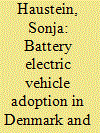

|
|
|
|
|
| Summary/Abstract |
Countries worldwide are trying to increase the share of battery electric vehicles (BEVs) to reach environmental goals. As part of these efforts, the EU project GREAT installed new fast chargers in Denmark and Sweden and provided possibilities to test BEVs and inform about them. To monitor changes in attitudes and behaviours and to estimate the impact of project activities, surveys with BEV and conventional car users were conducted in 2017, 2018, and 2019. We found that attitudes and driving behaviour of BEV users and non-users remained quite stable. While car users in Denmark and Sweden showed similar profiles, one exception was a more negative evaluation of and higher uncertainty about political support for BEVs by Danes. Modelling purchase intention, we found a significant effect of the new fast chargers in Denmark but not in Sweden, while the opposite was the case for information campaigns. Lifestyle compatibility and symbolic-affective attitudes were relevant for BEV adoption in both countries. For cross-border trips, the most relevant factor was whether people had a Tesla or not, reflecting the better driving range and fast charging infrastructure. An increase of charging infrastructure, clearer policy signals and symbolic-affective marketing are discussed as ways to increase BEV adoption.
|
|
|
|
|
|
|
|
|
|
|
|
|
|
|
|
| 5 |
ID:
171508


|
|
|
|
|
| Summary/Abstract |
We investigate the question of whether spending to enable ambitious EV roll-out programmes can in fact generate net gains across the wider economy. We use a multi-sector computable general equilibrium (CGE) model for the UK economy and focus on the need to upgrade electricity networks to support an initial EV penetration scenario for the period to 2030. We find that large scale spending and cost recovery for network upgrades is likely to result in net negative impacts on key macroeconomic indicators, including real income available for spending across all UK households. This is due to a combination of time-limited network upgrade activity in the presence of capacity constraints combined with the need for costs to be passed on to electricity consumers through higher bills. But the lowest income households – the group of greatest concern to policymakers – suffer the smallest losses. Moreover, the EV uptake delivers sufficient gains that deliver net positive impacts on all household incomes, with sustained expansion in GDP and employment across the economy. The key driver is a greater reliance on UK supply chains with the shift away from more import-intensive petrol and diesel fuelled vehicles towards electric ones.
|
|
|
|
|
|
|
|
|
|
|
|
|
|
|
|
| 6 |
ID:
123244


|
|
|
| 7 |
ID:
092603
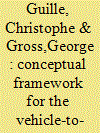

|
|
|
|
|
| Publication |
2009.
|
| Summary/Abstract |
The paper focuses on presenting a proposed framework to effectively integrate the aggregated battery vehicles into the grid as distributed energy resources to act as controllable loads to levelize the demand on the system during off-peak conditions and as a generation/storage device during the day to provide capacity and energy services to the grid. The paper also presents practical approaches for two key implementation steps - computer/communication/control network and incentive program.
|
|
|
|
|
|
|
|
|
|
|
|
|
|
|
|
| 8 |
ID:
180117
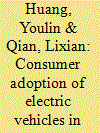

|
|
|
|
|
| Summary/Abstract |
Electric vehicles (EVs) are one of the major green technologies, and existing literature has extensively examined consumer adoption of EVs in an EV-buying business model. By contrast, little attention has been paid to consumers' adoption of EVs in non–ownership-based business models. To fill this literature gap, this study examines the psychological antecedents to, and influencing mechanism for, consumers to adopt EVs in different business models. Using time-lagged design, we show that need for uniqueness (NFU) trait enhances consumers' psychosocial view of EVs. This in turn promotes consumers' intention to adopt EVs in innovative business models such as EV leasing and business-to-consumer EV sharing. We further find that risk aversion negatively affects intention to adopt EVs in innovative business models only. Furthermore, consumers' intention to adopt EVs in innovative business models is positively associated with their intention to buy EVs. Moving beyond the EV-buying business model, we contribute to the sustainable innovation literature by exploring the psychological antecedents to, and mediator of, the psychosocial view in consumers’ adoption of EVs in different business models. Our work has significant value for green marketing and public policies of sustainable innovations.
|
|
|
|
|
|
|
|
|
|
|
|
|
|
|
|
| 9 |
ID:
125475
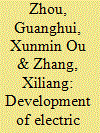

|
|
|
|
|
| Publication |
2013.
|
| Summary/Abstract |
China has promoted the use of electric vehicles vigorously since 2009; the program is still in its pilot phase. This study investigates the development of electric vehicle use in China from the perspectives of energy consumption and greenhouse-gas (GHG) emissions. Energy consumption and GHG emissions of plug-in hybrid electric vehicles (PHEVs) and pure battery electric vehicles (BEVs) are examined on the level of the regional power grid in 2009 through comparison with the energy consumption and GHG emissions of conventional gasoline internal combustion engine vehicles. The life-cycle analysis module in Tsinghua-LCAM, which is based on the GREET platform, is adopted and adapted to the life-cycle analysis of automotive energy pathways in China. Moreover, medium term (2015) and long term (2020) energy consumption and greenhouse-gas emissions of PHEVs and BEVs are projected, in accordance with the expected development target in the Energy Efficient and Alternative Energy Vehicles Industry Development Plan (2012-2020) for China. Finally, policy recommendations are provided for the proper development of electric vehicle use in China.
|
|
|
|
|
|
|
|
|
|
|
|
|
|
|
|
| 10 |
ID:
180098


|
|
|
|
|
| Summary/Abstract |
The path towards light-duty vehicle electrification promises benefits like lower costs for drivers and reduced environmental externalities for all. Incentives such as electric vehicle rebates assist with alleviating high capital costs of alternative fuel cars. We uncover distributional effects of plug-in electric vehicle rebates, focusing on a program in the State of California. We use economic attributes representative of populations of census tracts as well as data on rebates distributed to plug-in electric vehicle buyers through the Clean Vehicle Rebate Project from 2010 to 2018. Horizontal and vertical equity measures are evaluated, while measurement of spatial association characterizes spatial patterns of rebates allocation across the State. We evaluate the distributional fairness of rebates allocation between income groups and disadvantaged communities. We find that rebates have been predominantly given to high income electric vehicle buyers. However, the share of rebates distributed to low-income groups and disadvantaged communities increased over time and after an income-cap policy was put into effect. Spatial analysis shows high spatial clustering effects and rebates concentration in major metropolitan regions. We reveal neighborhood effects: communities with lower median income or disadvantaged receive higher rebate amounts when these are geographic neighbors to clusters characterized as high rebate amount receivers.
|
|
|
|
|
|
|
|
|
|
|
|
|
|
|
|
| 11 |
ID:
177362
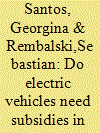

|
|
|
|
|
| Summary/Abstract |
We analyse the total cost of ownership of petrol, diesel, hybrid electric vehicles, plug-in hybrid electric vehicles and battery electric vehicles in the UK over 2017–2029. We do this for large, medium and small cars, under assumptions of 0%, 6%, 30% and 60% discount rates. We find that some electric car models from mass market brands are close to reaching cost parity with their petrol, diesel and hybrid counterparts, but subsidies would accelerate their uptake, especially for impatient consumers with high discount rates. Plug-in hybrid electric vehicles are not worth the effort because, although relatively low, their CO2 emissions are non-zero, and their purchase price is as high or even higher than that of battery electric vehicles. A subsidy of £4,500 or an exemption from the 20% VAT, perhaps capped at £4,500, would accelerate mass market penetration of battery electric vehicles in the UK. If decarbonising road transport were not as urgent as it is, the market for battery electric vehicles could be left to develop on its own, without government intervention. However, because the cost of batteries is not falling fast enough, subsidies are needed in the short term.
|
|
|
|
|
|
|
|
|
|
|
|
|
|
|
|
| 12 |
ID:
112241
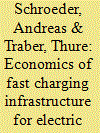

|
|
|
|
|
| Publication |
2012.
|
| Summary/Abstract |
By 2011 little is known about the economic rationale of public fast chargers for electric vehicles (EV). This paper aims at providing an insight into the business case of this technology in a case study for Germany. The estimated Return on Investment (ROI) of a public fast charging station constitutes the main contribution. Potential users and organization structures are investigated as well as different tariff types. According to the estimations, the current market outlook seems too uncertain for triggering a large-scale roll-out of fast charging infrastructure. Approximations suggest that investment is hardly profitable at low EV adoption rates, unless investment cost can be severely lowered. Besides competition with alternative charging solutions, the general EV adoption rate is detected as being a main risk factor for investment in public charging infrastructure.
|
|
|
|
|
|
|
|
|
|
|
|
|
|
|
|
| 13 |
ID:
115670


|
|
|
|
|
| Publication |
2012.
|
| Summary/Abstract |
There is an increasing impetus to transform the U.S transportation sector and transition away from the uncertainties of oil supply. One of the most viable current solutions is the adoption of electric vehicles (EVs). These vehicles allow for a transportation system that would be flexible in its fuel demands. However, utilities may need to address questions such as distribution constraints, electricity tariffs and incentives and public charging locations before large scale electric vehicle adoption can be realized. In this study, the effect of electric vehicles on households in Indianapolis is examined. A four-step traffic flow model is used to characterize the usage characteristics of vehicles in the Indianapolis metropolitan area. This data is then used to simulate EV usage patterns which can be used to determine household electricity usage characteristics. These results are differentiated by the zones with which the households are associated. Economic costs are then calculated for the individual households. Finally, possible public charging locations are examined.
|
|
|
|
|
|
|
|
|
|
|
|
|
|
|
|
| 14 |
ID:
166474
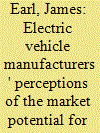

|
|
|
|
|
| Summary/Abstract |
While there is extensive research on the technical potential of electric vehicles (EVs) to provide electricity system flexibility, no work has sought to understand how EV manufacturers see their role in this transition. Here we present an interview study with 11 EV manufacturers active in the UK, determining their perceptions on the market potential for demand-side flexibility using EVs. Findings indicate manufacturers view significant potential in this market, but believe time is needed (i.e. in the 2020s) for the EV market to develop before there is enough system/consumer demand for flexibility using EVs. They believe better price signals are needed, and prefer a consumer-led approach (rather than, for example, mandatory smart charging). Most manufacturers recognise they have a role in making flexibility a viable offering, but for it to succeed it needs coordination with other players, notably energy suppliers, aggregators, network operators and consumers. Governments should have a role in encouraging and brokering such partnerships. There was little evidence of concern that network constraints resulting from multiple EVs charging on the same circuit could act as a brake on sales. We identify a risk that EV growth could outpace available infrastructure and flexibility market mechanisms, leading to grid management challenges.
|
|
|
|
|
|
|
|
|
|
|
|
|
|
|
|
| 15 |
ID:
096746
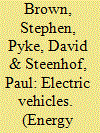

|
|
|
|
|
| Publication |
2010.
|
| Summary/Abstract |
After nearly a century with the internal combustion engine dominating the personal transportation sector, it now appears that the electric vehicle is on the verge of experiencing rapid growth in both developed and developing vehicle markets. The broad-scale adoption of the electric vehicle could bring significant changes for society in terms of not only the technologies we use for personal transportation, but also moving our economies away from petroleum and lessoning the environmental footprint of transportation. This article investigates the role of standards, related training and certification for the electric vehicle. It is argued that the potential for the electric vehicle will be stunted without adequate attention being paid to standards, not only in terms of the speed of its uptake and smoothness of this transition, but also in terms of maintaining compatibility between jurisdictions, safety of the public, and helping to ensure environmental sustainability. We highlight a number of areas where new or adaptations of current standards, training and certification may be needed, notably in terms of batteries and charging infrastructures, electricity distribution and accounting for the environmental characteristics of this electricity, and different aspects of vehicle-to-grid and smart grid technologies.
|
|
|
|
|
|
|
|
|
|
|
|
|
|
|
|
| 16 |
ID:
097601
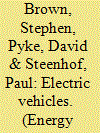

|
|
|
|
|
| Publication |
2010.
|
| Summary/Abstract |
After nearly a century with the internal combustion engine dominating the personal transportation sector, it now appears that the electric vehicle is on the verge of experiencing rapid growth in both developed and developing vehicle markets. The broad-scale adoption of the electric vehicle could bring significant changes for society in terms of not only the technologies we use for personal transportation, but also moving our economies away from petroleum and lessoning the environmental footprint of transportation. This article investigates the role of standards, related training and certification for the electric vehicle. It is argued that the potential for the electric vehicle will be stunted without adequate attention being paid to standards, not only in terms of the speed of its uptake and smoothness of this transition, but also in terms of maintaining compatibility between jurisdictions, safety of the public, and helping to ensure environmental sustainability. We highlight a number of areas where new or adaptations of current standards, training and certification may be needed, notably in terms of batteries and charging infrastructures, electricity distribution and accounting for the environmental characteristics of this electricity, and different aspects of vehicle-to-grid and smart grid technologies.
|
|
|
|
|
|
|
|
|
|
|
|
|
|
|
|
| 17 |
ID:
112243
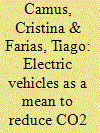

|
|
|
|
|
| Publication |
2012.
|
| Summary/Abstract |
Most of small islands around the world today, are dependent on imported fossil fuels for the majority of their energy needs especially for transport activities and electricity production. The use of locally renewable energy resources and the implementation of energy efficiency measures could make a significant contribution to their economic development by reducing fossil fuel imports. An electrification of vehicles has been suggested as a way to both reduce pollutant emissions and increase security of supply of the transportation sector by reducing the dependence on oil products imports and facilitate the accommodation of renewable electricity generation, such as wind and, in the case of volcanic islands like São Miguel (Azores) of the geothermal energy whose penetration has been limited by the valley electricity consumption level. In this research, three scenarios of EV penetration were studied and it was verified that, for a 15% LD fleet replacement by EVs with 90% of all energy needs occurring during the night, the accommodation of 10 MW of new geothermal capacity becomes viable. Under this scenario, reductions of 8% in electricity costs, 14% in energy, 23% in fossil fuels use and CO2 emissions for the transportation and electricity production sectors could be expected.
|
|
|
|
|
|
|
|
|
|
|
|
|
|
|
|
| 18 |
ID:
109650
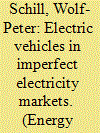

|
|
|
|
|
| Publication |
2011.
|
| Summary/Abstract |
We use a game-theoretic model to analyze the impacts of a hypothetical fleet of plug-in electric vehicles on the imperfectly competitive German electricity market. Electric vehicles bring both additional demand and additional storage capacity to the market. We determine the effects on prices, welfare, and electricity generation for various cases with different players in charge of vehicle operations. Vehicle loading increases generator profits, but decreases consumer surplus in the power market. If excess vehicle batteries can be used for storage, welfare results are reversed: generating firms suffer from the price-smoothing effect of additional storage, whereas power consumers benefit despite increasing overall demand. Strategic players tend to under-utilize the storage capacity of the vehicle fleet, which may have negative welfare implications. In contrast, we find a market power-mitigating effect of electric vehicle recharging on oligopolistic generators. Overall, electric vehicles are unlikely to be a relevant source of market power in Germany in the foreseeable future.
|
|
|
|
|
|
|
|
|
|
|
|
|
|
|
|
| 19 |
ID:
125750


|
|
|
|
|
| Publication |
2013.
|
| Summary/Abstract |
We use a newly developed bottom-up model of the entire Canadian energy system (TIMES-Canada) to assess potentials for electrification of the road transport sector. A special emphasis has been put on the modelling of the Canadian road transport, by considering a variety of vehicles for passenger and freight transportation. Besides a business-as-usual (baseline) scenario, we have analysed an energy policy scenario imposing targets for electric vehicle penetration and a climate policy scenario imposing targets for greenhouse gas emission reduction. Our analysis shows on the one hand that electric vehicles penetrate notably the passenger vehicle market after 2040 in the baseline scenario and after 2030 in the energy policy scenario (following the assumed penetration targets). On the other hand, the assumed climate policy forces a stronger penetration of electric vehicles for passenger transportation, with a progressive phasing out of internal combustion engine vehicles, whereas the latter vehicles remain dominant for freight transportation but with a shift away of fossil fuels and in favour of biofuels. A sensitivity analysis on the (assumed) evolution of electric vehicles over time confirms these general trends.
|
|
|
|
|
|
|
|
|
|
|
|
|
|
|
|
| 20 |
ID:
185715
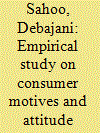

|
|
|
|
|
| Summary/Abstract |
The present study empirically investigates the motives behind users’ attitude formation, behavioural intention, and word of mouth towards electric vehicles. An online survey was conducted among Indian youths who are currently using or potential users of electric vehicles. Data were collected by applying a multi-stage stratified sampling method. The structural equation modelling technique was applied to examine the hypothesized model and tested the proposed hypotheses. This study results show that while positive and social motives influence positive attitudes, the negative motives discourage and negatively affect electric vehicle adoption. The moderating impact of buyer involvement (high vs low) between motives and attitude was also tested. The study findings suggest that stakeholders can shape the motives through government policy and strategic action. Thus, this study provides directions that there is a need for subsidies and incentives, such as hassle-free registration at less cost, tax waive offs from central, state and local government, and also a strategic private-public partnership for infrastructure development to reduce negative motives and boost electric vehicles penetration.
|
|
|
|
|
|
|
|
|
|
|
|
|
|
|
|
|
|
|
|
|